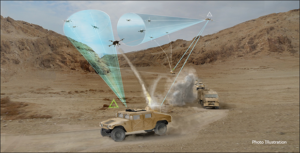 The American army’s high think-tank is as soon as once more wanting to researchers to create new and higher drone mitigation options.
The American army’s high think-tank is as soon as once more wanting to researchers to create new and higher drone mitigation options.
Last week, the Defense Advanced Research Projects Agency issued a Request for Information (RFI) to “identify promising [drone]-sensing and -neutralization technologies that could augment or complement [DARPA’s Mobile Force Protection (MFP)] program currently under development.”
The company’s MFP is tasked with creating an built-in system that may defeat “self-guided” drones – outlined as UAVs “that do not rely on a radio or GPS receiver for their operation.” By discovering new anti-drone programs, DARPA hopes to defend high-value army convoys from rogue drone assaults.
“Keeping warfighters safe from small unmanned air systems requires knowing that one or more is coming and removing their potential as a threat while they’re still at a safe distance,” stated Jean-Charles Ledé, a program supervisor in DARPA’s Tactical Technology Office (TTO). “This RFI aims to help DARPA stay abreast of the latest technologies that could provide those capabilities, and integrate some of the most promising ones into an eventual MFP technology demonstration system.”
Anyone could apply immediately to DARPA; nonetheless, all entries have to be prepared to carry out in subject exams by January.
“The RFI invitations brief white papers (not more than three pages plus a canopy sheet) describing the respondent’s know-how. All responses and queries in regards to the RFI have to be emailed to [email protected]. Responses will probably be accepted till four pm Eastern on Monday, October 2.”
DARPA officers will choose round 20 submissions and successful innovators will probably be invited to a one-day MFP Technology Day at DARPA’s workplaces in Arlington, Va.
This shouldn’t be DARPA’s first try to develop anti-drone capabilities. Last 12 months, the Pentagon’s futuristic assume tank introduced the same RFI to develop “novel, flexible, mobile layered” anti-drone options to defend “fixed and mobile ground and naval forces from possible drone threats.” The company additionally launched the Aerial Dragnet program “to provide persistent, wide-area surveillance of all [drones] operating below 1,000 feet in a large city,”
“Commercial websites currently exist that display in real time the tracks of relatively high and fast aircraft—from small general aviation planes to large airliners—all overlaid on geographical maps as they fly around the country and the world,” DARPA program supervisor Jeff Krolik stated.
 Unmanned Aerial Vehicle The latest drone news
Unmanned Aerial Vehicle The latest drone news


